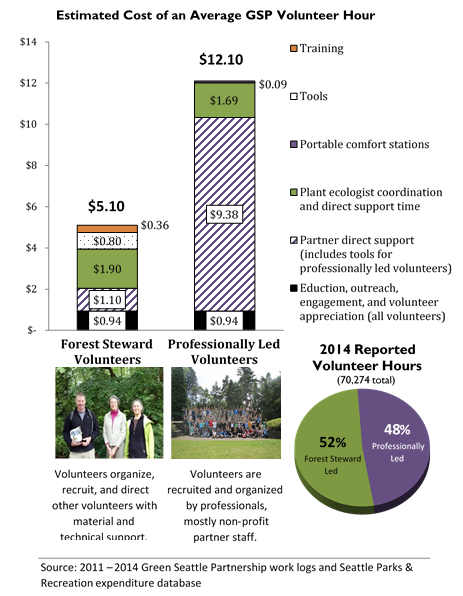 We don’t need qualitative analysis, statistics, or assignments of monetary value to know how important Forest Stewards and volunteers are to our forests and communities. But these techniques can help, especially when justifying expenditures on programs like the Green Seattle Partnership. Seattle Parks & Recreation staff involved in the GSP conducted an analysis and put together a report that looks back on 3 years of categorized expenditures and work log data from the GSP in order to demonstrate the value that volunteers bring compared to professional staff (in a very narrow sense – limited to completion of tasks in the field). Our results may surprise you – or perhaps not!
We don’t need qualitative analysis, statistics, or assignments of monetary value to know how important Forest Stewards and volunteers are to our forests and communities. But these techniques can help, especially when justifying expenditures on programs like the Green Seattle Partnership. Seattle Parks & Recreation staff involved in the GSP conducted an analysis and put together a report that looks back on 3 years of categorized expenditures and work log data from the GSP in order to demonstrate the value that volunteers bring compared to professional staff (in a very narrow sense – limited to completion of tasks in the field). Our results may surprise you – or perhaps not!
It’s important to note before getting into this, that all of these are estimates based on large data sets. There are exceptions to every rule (except that one, hehe) and in almost all circumstances there’s some deviation from the averages or medians provided. That being said:
We started by looking at the costs associated with volunteers verses professional labor. It turns out that the GSP has two main categories of each. On the volunteer end, there are the volunteers including and recruited by Forest Stewards, which tend to be less expensive on an average estimated per-hour basis than the other category, professionally-led volunteers, who, you guessed it, have a paid professional leading them. We estimate that the average cost to the city for a Forest Steward volunteer hour is about $5.00, including all of the training, staff support, education, tools, and outreach that goes into that program, while that a professionally led volunteer hour costs the City about $12.00. Both of these types of volunteers are far less expensive on a per hour basis than professional staff, who clock in at closer to $40 / hour.
“But,” you may say “certainly professionals can get more done in an hour than volunteers,” and in most cases you’re right. Luckily, years of work log data and the ability to filter out those work logs in which only one type of task was reported against the hours reported gave us the ability to convert estimated costs per hour into estimated costs per expected task output. And guess what? With only a few exceptions, volunteers, especially Forest Steward volunteers, provided the best value. We’ll let you read the full report for more details.
Additionally, volunteers accomplish some things that professional crews just can’t. They bring local insight and ownership to make restoration projects that much more successful. Their long-term commitment helps projects keep momentum through changing budget cycles, City priorities, and individual staff members who may come and go. They build community resiliency by developing relationships and getting neighbors working together. They activate open space and increase visibility to discourage crime. They educate each other, facilitate more active communities, and much more. Many of these things are hard to quantify. But when you add them to the already-impressive restoration effort on the ground, it’s clear that volunteers are helping all of Seattle come out ahead.
